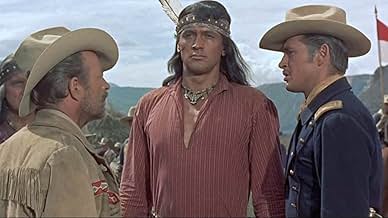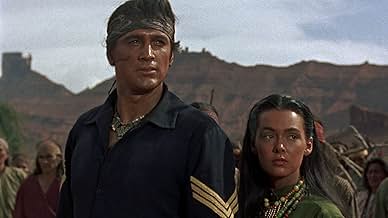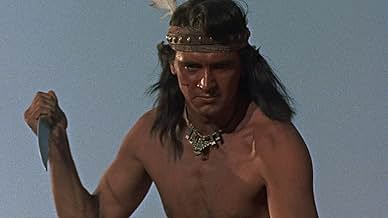IMDb रेटिंग
5.6/10
1.1 हज़ार
आपकी रेटिंग
जब अपाचे प्रमुख कोचिस की मृत्यु हो जाती है, तो चिरिकहुआ अपाचे कोचिस के शांतिप्रिय बेटे ताज़ा के बाद और युद्ध के पाखण्डी अपाचे योद्धा गेरोनिमो के पीछे फटे हुए हैं.जब अपाचे प्रमुख कोचिस की मृत्यु हो जाती है, तो चिरिकहुआ अपाचे कोचिस के शांतिप्रिय बेटे ताज़ा के बाद और युद्ध के पाखण्डी अपाचे योद्धा गेरोनिमो के पीछे फटे हुए हैं.जब अपाचे प्रमुख कोचिस की मृत्यु हो जाती है, तो चिरिकहुआ अपाचे कोचिस के शांतिप्रिय बेटे ताज़ा के बाद और युद्ध के पाखण्डी अपाचे योद्धा गेरोनिमो के पीछे फटे हुए हैं.
Rex Reason
- Naiche
- (as Bart Roberts)
Eugene Iglesias
- Chato
- (as Gene Iglesias)
Richard H. Cutting
- Cy Hegan
- (as Richard Cutting)
Bradford Jackson
- Lt. Richards
- (as Brad Jackson)
Seth Bigman
- Indian Man
- (बिना क्रेडिट के)
फ़ीचर्ड समीक्षाएं
When Cochise (played briefly by an uncredited Jeff Chandler) dies, his son Taza (played by Rock Hudson) takes over as chief of the Chiricahua Apaches and tries to maintain the peace. Followers of Geronimo wish to start fighting again.
It's a thoughtful script, and director Douglas Sirk claimed it was his favorite of his movies; he had always wanted to make a western. There are some issues with the movie, some caused by technical issues, and most by Rock Hudson's rather wooden acting. He's got two settings, thoughtful and angry, and that performance makes him, as the central character, seem rather stupid, especially given the more nuanced performances afforded the men playing cavalrymen.
The technical issues can be understood by knowing this was originally shot for 3-D, but released in a flat version. The compositions meant to showcase the depth of shot stick out like a sore thumb, lending a peculiarly film noir look to them. While Russel Metty's camerawork is exemplary in the big-screen shots of Utah, many of the more intimate scenes show up in a peculiarly dark and grey light.
The script by George Zuckerman keeps things moving along, but the problems of performance and camerawork lay heavily on this movie. Sirk and producer Ross Hunter abandoned the western for a series of glossy soap operas.
It's a thoughtful script, and director Douglas Sirk claimed it was his favorite of his movies; he had always wanted to make a western. There are some issues with the movie, some caused by technical issues, and most by Rock Hudson's rather wooden acting. He's got two settings, thoughtful and angry, and that performance makes him, as the central character, seem rather stupid, especially given the more nuanced performances afforded the men playing cavalrymen.
The technical issues can be understood by knowing this was originally shot for 3-D, but released in a flat version. The compositions meant to showcase the depth of shot stick out like a sore thumb, lending a peculiarly film noir look to them. While Russel Metty's camerawork is exemplary in the big-screen shots of Utah, many of the more intimate scenes show up in a peculiarly dark and grey light.
The script by George Zuckerman keeps things moving along, but the problems of performance and camerawork lay heavily on this movie. Sirk and producer Ross Hunter abandoned the western for a series of glossy soap operas.
Universal joined the parade of film studios that wanted to cash in on the popularity of Indian chiefs during the 1950s. This western followed the familiar formula of war and peace, reservation vs. warpath story lines, trigger happy soldiers and renegade Indians. Rock Hudson stars as the obedient, peace-loving son of Cochise in this Arizona saga but his brother opposes the chief's death-bed wish and schemes with other Indians to break free to raid and plunder. That is essentially the plot here, with nothing new to offer fans of this genre. The movie has enough action and scenic vistas to maintain interest but also looks like it was filmed on a shoestring budget. Hudson and Barbara Rush make a fetching couple and the supporting cast is good but the film lacks the polish of other Universal westerns of this period.
Taza, Son of Cochise is directed by Douglas Sirk and written by Gerald Drayson Adams and George Zuckerman. It stars Rock Hudson, Barbara Rush, Gregg Palmer, Rex Reason and Morris Ankrum. A Technicolor production with the Music scored by Frank Skinner and cinematography by Russell Metty.
In 1872 the long bitter war fought between the United States Cavalry troops and Apache bands led by Cochise came to an end. The peace treaty signed by Cochise and General Howard brought peace to the Arizona Territory. But three years later the mighty leader of the Chiricahua Apaches grew ill and come to the end of his days....
....the torch was passed to his first born son, Taza, who wants to follows his father's ideals and peace brokering ways. His second born son, Naiche, however, has different ideas, as does the mighty Geronimo.....
Douglas Sirk's only venture into the Western realm was originally shot in 3D around the gorgeous Arches National Monument Park. Following the pro-Indian theme that was becoming a feature of 1950s Westerns, it's a film that suffers primarily because of the casting of none Native Americans in the important character roles. Which is a shame because it's a gorgeous production that features action scenes full of vim and vigour. Story isn't out of the ordinary and the dialogue is often clunky as the Indian chatter is of the Hollywoodisation kind. Yet picture is never dull, the interest is always held as Taza attempts to hold on to peace for his people, whilst simultaneously he's trying to court the hand of Oona (Rush) against the wishes of her father, the war mongering Grey Eagle (Ankrum).
Hudson, badly cast as he is, can't be faulted for commitment in the title role. He clearly feels at ease working for Sirk (it was a coupling that would work together on a total of 9 movies), and at least he has the physicality for such a character. Unlike Ian MacDonald as Geronimo, who looks too old, is too staid and sticks out like a sore thumb. Russell Metty's photography is top draw, both in capturing gorgeous frames of the locale and in choice of colour lenses. Skinner provides a breezy, if standard Indian tinted Western musical score, and Sirk's direction is simple and effective with only minimal 3D moments part of the action. It's hardly an essential picture in the pantheon of pro-Indian Westerns, but it's better than it has a right to be, and with Pegasus' DVD release providing a lovely print, this is worth seeking out if only for Russell Metty's fine work. 6.5/10
In 1872 the long bitter war fought between the United States Cavalry troops and Apache bands led by Cochise came to an end. The peace treaty signed by Cochise and General Howard brought peace to the Arizona Territory. But three years later the mighty leader of the Chiricahua Apaches grew ill and come to the end of his days....
....the torch was passed to his first born son, Taza, who wants to follows his father's ideals and peace brokering ways. His second born son, Naiche, however, has different ideas, as does the mighty Geronimo.....
Douglas Sirk's only venture into the Western realm was originally shot in 3D around the gorgeous Arches National Monument Park. Following the pro-Indian theme that was becoming a feature of 1950s Westerns, it's a film that suffers primarily because of the casting of none Native Americans in the important character roles. Which is a shame because it's a gorgeous production that features action scenes full of vim and vigour. Story isn't out of the ordinary and the dialogue is often clunky as the Indian chatter is of the Hollywoodisation kind. Yet picture is never dull, the interest is always held as Taza attempts to hold on to peace for his people, whilst simultaneously he's trying to court the hand of Oona (Rush) against the wishes of her father, the war mongering Grey Eagle (Ankrum).
Hudson, badly cast as he is, can't be faulted for commitment in the title role. He clearly feels at ease working for Sirk (it was a coupling that would work together on a total of 9 movies), and at least he has the physicality for such a character. Unlike Ian MacDonald as Geronimo, who looks too old, is too staid and sticks out like a sore thumb. Russell Metty's photography is top draw, both in capturing gorgeous frames of the locale and in choice of colour lenses. Skinner provides a breezy, if standard Indian tinted Western musical score, and Sirk's direction is simple and effective with only minimal 3D moments part of the action. It's hardly an essential picture in the pantheon of pro-Indian Westerns, but it's better than it has a right to be, and with Pegasus' DVD release providing a lovely print, this is worth seeking out if only for Russell Metty's fine work. 6.5/10
Jeff Chandler reprises his role as Cochise (in "Broken Arrow") and, in the first ten minutes, dies after instructing his youngest son, Hudson's Taza, to keep the Apaches on the path of peace. Taza's half brother Nache (Rex Reason), however, wants to slaughter all white eyes. Barbara Rush is the Apache princess torn between the two brothers. On location, brutal desert sun, despite body make up, severely burned Hudson, mostly shirtless to exhibit his physique. Film was shot and released in 3-D with expected effects of rocks, spears, and arrows flying from the screen. As a churning Western, the Apache POV places "Taza" in a group of early 50s Westerns, such as "Broken Arrow" (James Stewart) and "The Savage" (Charlton Heston), that sided with Indians and culminated in "Apache" (Burt Lancaster). Moral score card is reckoned by pairing white and Apache villains. With brisk direction, handsome cast (notably Rush and Reason), and Technicolor capturing expanses of red-orange desert, "Taza" is respectably good of its kind. In dealing with Indians vs. whites, "Taza" may be a bit cavalier, but tongue-in-cheek? No. Hudson here was only one stair tread away from achieving major stardom in "Magnificent Obsession"--and looks it.
Don't get me wrong.I've always been a big fan of Deltlef Sierck (Douglas Sirk in America)and most of his melodramas are among my all time favorites : "A time to live and a time to die ","All that Heaven allows" "Magnificent obsession" " Tarnished angels" "Written on the wind" plus those with Zarah Leander in Germany not to forget his final effort ,the remake of "imitation of life".
THis remake was drastically different from Stahl's version:the black servant Delilah became Annie and the only thing she could expect in life was a beautiful funeral.In Stahl's version (and in Fannie Hurst's novel) she was a businesswoman's associate ,in Sirk's screenplay she stayed the good servant -not very far away from GWTW's Mamma-who knew her place.
Still with me?I do think that,in spite of Sirk's storyteller qualities and good scenes (the discovery of the bruises on Barbara Rush's back),"Taza" is also a reactionary work .Taza (who in real life died of pneumonia two years after his dad)predates Annie in "Imitation" :he is the good Indian,who knows his place ,who (this is amazing) dresses like them ,who rebels against his people's customs and even fights them;on the other hand ,Geronimo (and his allies) plays the role of the villain : "we were hunters, warriors,we won't be breeders ".After all ,the white men are taking their land and sending them to reservations:his rebellion makes sense.
Rock Hudson,who was Sirk's favorite actor (his best parts were certainly "All that Heaven allows" and "Magnificent Obsession" -another remake of a Stahl's work-) ,is not well cast as an Indian.And what about Barbara Rush as a squaw?Debra Paget was acceptable ("Broken Arrow"),she is not.
THis remake was drastically different from Stahl's version:the black servant Delilah became Annie and the only thing she could expect in life was a beautiful funeral.In Stahl's version (and in Fannie Hurst's novel) she was a businesswoman's associate ,in Sirk's screenplay she stayed the good servant -not very far away from GWTW's Mamma-who knew her place.
Still with me?I do think that,in spite of Sirk's storyteller qualities and good scenes (the discovery of the bruises on Barbara Rush's back),"Taza" is also a reactionary work .Taza (who in real life died of pneumonia two years after his dad)predates Annie in "Imitation" :he is the good Indian,who knows his place ,who (this is amazing) dresses like them ,who rebels against his people's customs and even fights them;on the other hand ,Geronimo (and his allies) plays the role of the villain : "we were hunters, warriors,we won't be breeders ".After all ,the white men are taking their land and sending them to reservations:his rebellion makes sense.
Rock Hudson,who was Sirk's favorite actor (his best parts were certainly "All that Heaven allows" and "Magnificent Obsession" -another remake of a Stahl's work-) ,is not well cast as an Indian.And what about Barbara Rush as a squaw?Debra Paget was acceptable ("Broken Arrow"),she is not.
क्या आपको पता है
- ट्रिवियाDouglas Sirk often cited this film as the favorite of his own films since he always wanted to make a Western.
- गूफ़The official U.S. flag of 1872, the year the story takes place, did have 37 stars in five rows, however it consisted of a top and bottom row of eight stars with three rows of seven stars in between (8-7-7-7-8), not alternating rows of seven and eight (7-8-7-8-7) as the one in the film has.
- कनेक्शनFeatured in Rock Hudson's Home Movies (1992)
टॉप पसंद
रेटिंग देने के लिए साइन-इन करें और वैयक्तिकृत सुझावों के लिए वॉचलिस्ट करें
- How long is Taza, Son of Cochise?Alexa द्वारा संचालित
विवरण
- रिलीज़ की तारीख़
- कंट्री ऑफ़ ओरिजिन
- भाषाएं
- इस रूप में भी जाना जाता है
- Son of Cochise
- फ़िल्माने की जगहें
- Devils Garden, Arches National Park, यूटा, संयुक्त राज्य अमेरिका(cavalry ambush scene)
- उत्पादन कंपनी
- IMDbPro पर और कंपनी क्रेडिट देखें
- चलने की अवधि
- 1 घं 19 मि(79 min)
- पक्ष अनुपात
- 2.00 : 1
इस पेज में योगदान दें
किसी बदलाव का सुझाव दें या अनुपलब्ध कॉन्टेंट जोड़ें



































